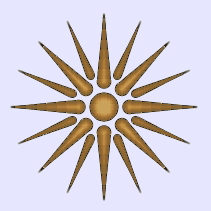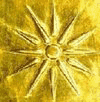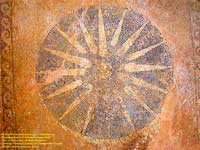.

The Vergina Sun, Star of Vergina or Argead Star is the name given to a symbol of a stylised star or sun with sixteen rays. It was unearthed in 1977 during archaeological excavations in Vergina, in the northern Greek region of Macedonia, by Professor . He discovered it on a golden larnax in the tombs of the kings of the ancient kingdom of Macedon.
Andronikos described the symbol variously as a "star", a "starburst" or as a "sunburst".[1] He proposed that the larnax on which it appears belonged to King Philip II of Macedon, the father of Alexander the Great, though some have attributed it to Alexander the Great's half-brother, Philip III Arrhidaeus.[2] The larnax is on display at the archaeological museum in Vergina, where it was found. Another version of the Vergina Sun, with 12 rays, was found on the larnax of Olympias, the mother of Alexander the Great.
Since its rediscovery, it has taken on a new function as a political symbol associated with modern Macedonia, and has become the object of political conflict between Greeks and Macedonians. Both regard it as a national symbol, although it's an official, WIPO-protected state symbol only in Greece.

Larnax thought to have belonged to King Philip II of Macedon, father of Alexander the Great.

Vergina Sun with 12 rays, as found on the larnax of Olympias .
Interpretations of the symbol
The significance of the Vergina Sun is unclear. Archaeologists do not agree whether the sun was a symbol of Macedon, an emblem of Philip's Argead dynasty, a religious symbol representing the Twelve Gods of Olympus, or simply a decorative design. Andronikos repeatedly interprets it as the "emblem of the Macedonian dynasty", though Eugene Borza has pointed out that it is widely used in ancient Macedonian art.[3][4] John Paul Adams cites its long-established use as a decorative element in Greek art, as well as in the Middle East, Ancient Thrace[5] and elsewhere, and concludes that it cannot definitively be said that it was either a "royal" or "national" Macedonian symbol.[6] Sixteen and eight-pointed suns often appear in Macedonian and Hellenistic coins and shields of that period.[7] However, there are also a number of depictions of Athenian hoplites[8][9] bearing an identical sixteen-pointed symbol on their armor as early as the 6th century BC,[10] as well as coin designs from island and mainland Greece bearing eight or sixteen-pointed sun symbols (Corfu, 5th century BC,[11] Locris, 4th century BC[12][13]). Before 1977 the symbol had been regarded as a simple ornament. After Andronikos' discovery, the symbol began to be viewed as predominantly associated with Ancient Macedonians, despite its earlier ornamental use in Greek art.

16 Rays Macedonian Star , Greece,
References
1. ^ Danforth, L. M. The Macedonian Conflict: Ethnic Nationalism in a Transnational World, p. 163. Princeton University Press, 1997
2. ^ Not Philip II of Macedon
3. ^ W. Lindsay Adams and Eugene N. Borza, eds. Philip II, Alexander the Great and the Macedonian Heritage, p. 82. University Press of America, 1982
4. ^ Macedonian miniature shield
5. ^ Въведение в Тракийската археология, Георги Китов, Даниела Агре, стр. 33-34, ИК Авалон, (in Bulgarian), ISBN 954-9704-07-6. [1]
6. ^ Adams, J.P. The Larnakes from Tomb II at Vergina. Archaeological News. 12:1-7
7. ^ Νικόλαος Μάρτης (January 10, 1999). "Γιατί ο τάφος της Βεργίνας ανήκει στον βασιλέα της Μακεδονίας Φίλιππο Β'" (in Greek). Το ΒΗΜΑ. http://tovima.dolnet.gr/print_article.php?e=B&f=12515&m=B06&aa=1.
8. ^ Ancient Greek vase depicting a hoplite with Vergina Sun as panoply decorative design, 5th century BC
9. ^ Argeads and the Vergina Sun
10. ^ "Greek Shield Patterns: 540-500 BC". Ritsumei.ac.jp. 2000-04-29. http://www.ritsumei.ac.jp/se/~luv20009/Greek_Shields540-500.html. Retrieved 2009-03-22.
11. ^ "Perseus:image:1990.26.0214". Perseus.tufts.edu. http://www.perseus.tufts.edu/cgi-bin/image?lookup=1990.26.0214. Retrieved 2009-03-22.
12. ^ "Perseus:image:1989.00.0174". Perseus.tufts.edu. http://www.perseus.tufts.edu/cgi-bin/image?lookup=1989.00.0174. Retrieved 2009-03-22.
13. ^ "Perseus:image:1990.26.0218". Perseus.tufts.edu. http://www.perseus.tufts.edu/cgi-bin/image?lookup=1990.26.0218. Retrieved 2009-03-22.
Sources
* Philip II, Alexander the Great and the Macedonian Heritage, ed. W. Lindsay Adams and Eugene N. Borza. University Press of America, 1982. ISBN 0-8191-2448-6
* The Larnakes from Tomb II at Vergina. Archaeological News. John Paul Adams
* In the Shadow of Olympus: The Emergence of Macedon, Eugene N. Borza. Princeton University Press, 1990. ISBN 0-691-05549-1
* "Macedonia Redux", Eugene N. Borza, in The Eye Expanded: life and the arts in Greco-Roman Antiquity, ed. Frances B Tichener & Richard F. Moorton. University of California Press, 1999. ISBN 0-520-21029-8
* Macedonia: The Politics of Identity and Difference, Jane K. Cowan. Pluto Press, 2000. ISBN 0-7453-1589-5
* The Macedonian Conflict: Ethnic Nationalism in a Transnational World, Loring M. Danforth. Princeton University Press, 1997. ISBN 0-691-04357-4
* Macedonia and Greece: The Struggle to Define a New Balkan Nation, McFarland & Company, 1997. ISBN 0-7864-0228-8
* Schell, Dorothea (1997). "Der Stern von Vergina als nationales Symbol in Griechenland". in R. W. Brednich and H. Schmitt, Münster et al.. Symbole: Zur Bedeutung der Zeichen in der Kultur. pp. 298–307, p. 301. ISBN 978-3-89325-550-4.
| Ancient Greece
Science, Technology , Medicine , Warfare, , Biographies , Life , Cities/Places/Maps , Arts , Literature , Philosophy ,Olympics, Mythology , History , Images Medieval Greece / Byzantine Empire Science, Technology, Arts, , Warfare , Literature, Biographies, Icons, History Modern Greece Cities, Islands, Regions, Fauna/Flora ,Biographies , History , Warfare, Science/Technology, Literature, Music , Arts , Film/Actors , Sport , Fashion --- |
Retrieved from "http://en.wikipedia.org/"
All text is available under the terms of the GNU Free Documentation License

